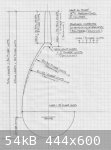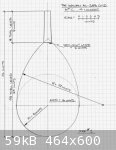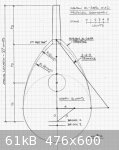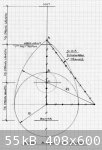| Pages:
1
2 |
jdowning
Oud Junkie
    
Posts: 3485
Registered: 8-2-2006
Location: Ontario, Canada
Member Is Offline
Mood: No Mood
|
|
This last result is not to say that Farmer's 'finger' unit of 2.25 cm should be discounted in all cases.
Al-Kindi the 9th C philosopher gives the position of the plectrum guard (midrab al-adwar) on an oud as fixed at 3 'asabi' from the bridge which is
equal to a tenth of the string length. So the string length of an oud in Al-Kind's time was 30 'finger' units.
Applying a 'finger' unit of value 2.25 cm gives - lo and behold - a string length of 67.5 cm!
For comparison let's look next at the geometry of another 14th C - that described in the Kanz al-Tuhaf ( Casket or Treasury of Music Rarities)
|
|
|
ALAMI
Oud Junkie
    
Posts: 645
Registered: 12-14-2006
Location: Beirut
Member Is Offline
Mood: No Mood
|
|
John, just a side note concerning the assumption that:
" the string length of 81 cm being practically unmanageable..."
Such a length is unmanageable for our modern playing techniques and compositions but is it so for ancient ways of playing oud
An old oudist told me that he went to Aleppo in the fifties to study with a well known master and that the master forced him to put horizontally a
pencil between his left hand fingers in a way so he can only use the first and third fingers to play, the second finger and the pinky being "disabled"
by being held behind the pencil, I am not sure if you can see what I mean, I don't have a camera to illustrate.
The point is that oud at the time was almost never used as a solo instrument, it was meant to accompany the singer, in fact Mawsili and Zeryab were
singers and composers and not just oudists like we may think today. Loudness and sustain may have been more important than playability in our modern
sense.
I don't know, it is just a thought. We know that the neck got shorter in the regions where instrumental and technically demanding music had its place:
first in Turkey, then in Iraq then with modern Arab oudists who start perform solo music.
|
|
|
jdowning
Oud Junkie
    
Posts: 3485
Registered: 8-2-2006
Location: Ontario, Canada
Member Is Offline
Mood: No Mood
|
|
This is, of course, an important observation Mahmoud. When using gut and silk strings - as were used exclusively on the oud from the 8th C (or before)
until at least the 18th C (I would guess), string length is of great importance. The longer the string length the easier it is to obtain a
satisfactory acoustic performance from the strings - particularly the thicker bass strings - although perhaps less of a problem for the early 4 course
ouds dating to the time of Mawsili and Ziryab (8th/9th C). According to Farmer the ouds of that time were also fretted so a string length of 81 cm
would have been valid for an instrument used for relatively slow vocal accompaniment.
The same parallel is found in the lute where the longest (fretted) string lengths were found on instruments like the archlute or chittarone used
mainly for voice or instrumental accompaniment (continuo playing). By the end of the 17th C and beyond, the French and German 'baroque' lutes had
fretted string length of around 69 to 73 cm - probably about the limit for a solo, fretted instrument. The bass strings (beyond the stopped 6th/7th
course strings) were longer but were only played 'open' like harp strings.
The shorter string length, wider bodied ouds seems to have made an appearance by the 14th C judging from the familiar engraving of an oud in 'Kitab
al-Adwar' (although it still has frets) that seems to match the geometry of the traditional Turkish oud quite well (so likely had a string length in
the range 54 cm to 58.5 cm ?)
My current thinking is that the longer string length, narrow bodied, fretted oud continued in use until the 16th C at which time some prominent German
luthiers - recognising a good thing when they heard it - used this design as the basis for their lutes, their reputation as outstanding luthiers of
their time extending beyond their lifetimes as a consequence. More on this later.

|
|
|
jdowning
Oud Junkie
    
Posts: 3485
Registered: 8-2-2006
Location: Ontario, Canada
Member Is Offline
Mood: No Mood
|
|
The dimensions of the oud described in the 14th C 'Kanz al-Tuhaf' - like the 'Ibn al-Tahhan' oud - appear to suffer from similar scribal error.
Curtis Bouterse has again proposed corrections to produce an instrument of more credible proportions. The attached image is drawn using the corrected
dimensions as well as my proposed upper sound board profile assuming a neck joint width of 2 'finger' units.
Note that the length of the neck is 1/4 of the overall length of the oud - a proportion found on ouds four centuries earlier. The width of this oud is
15 'finger' units (compared to 16 for the Ibn al-Tahhan oud) yet the value for R is the same equal to 32 'finger' units.
Out of curiosity I have superimposed a geometry assuming a neck length that is 1/3 string length and find that R becomes exactly 30 'finger' units
which when converted to a dimensionless number equals 8 (i.e. 30/15 x4 - as for the Ibn al-Tahhan oud with its equivalent neck proportion).
Again if Farmer's 'finger' unit of value 2.25 cm is applied, the string length is 67.5 cm. (or 56.25 cm if a 'finger' unit of
1.875 cm is used).

|
|
|
jdowning
Oud Junkie
    
Posts: 3485
Registered: 8-2-2006
Location: Ontario, Canada
Member Is Offline
Mood: No Mood
|
|
The study of historic Metrology is sometimes approached with ideas that are speculative and proposed solutions that are unproven so is considered by
the modern scientific community as a pseudoscience. These modern scientific materialists also apply the same category to Cosmology (the study of the
universe in its totality and humanity's place in it), Numerology (belief in a relationship between numbers and physical objects or living things),
belief in a Celestial Harmony or Harmony of the Spheres and Astrology (as it also relates to the movements of the planets). So most of the great
philosophers and scientists, past and present who have been engaged in these fields of study - the Ancient Egyptians and Greek philosophers such as
Plato and Ptolemy, Al-Kindi, the Ikhwan al-Safa, Kepler, Mersenne, and Newton - to name but a very few - must all be classed today as
'pseudoscientists'!
In the field of ancient metrology most scholars dismiss as unproven the conclusion of professor Livio Catullo Stecchini that all ancient measures are
by definition related - being derived by the ancients from their precise estimates of the circumference of the earth. Nevertheless it is of interest
to review what Stecchini has to say.
There were four fundamental types of ancient 'foot' linear measure - a foot consisting of 15 'fingers', one of 16 'fingers' (the basic foot), one of
17 'fingers' and another of 18 'fingers'. These were related by volume and weight so that, for example, an equal sided cubic measure with sides
measuring 16 'fingers' would weigh the same filled with water as one with sides measuring 17 'fingers' filled with wheat or one with sides measuring
18 'fingers' filled with barley. Stecchini designated these as a 'lesser foot' (15 'fingers'), a 'basic foot' (16 'fingers'), a 'wheat foot' (17
'fingers') and a 'barley foot' (18 'fingers'). The consistent value of a 'finger' - based upon the basic Egyptian foot of 30 cm - is 1.875 cm (16
'fingers' to a foot).
Stecchini then proposes a smaller 'trimmed' unit of value 1.85 cm based upon the Roman foot of 29.6 cm accounting for the difference between the
Egyptian and Roman foot - a ratio of 80:81 (or the 'discrepancy comma').
A cubit is a standard measure equal to 1.5 feet. so the common Egyptian cubit measured close to 45cm equal to 24 'fingers' ('finger' = 1.875 cm) and
the Royal cubit measured close to 52.5 cm equal to '28 fingers' ('finger' = 1.875 cm). As well there was a longer Persian royal cubit measuring 63.8
cm ('finger' = 2.28 cm).
Examples of Egyptian and Persian standard cubit measuring rods survive so it is possible to establish these values with some precision.
The Roman foot of 29.6 cm value was originally divided into 16 'fingers' ('finger = 1.850 cm). Then - just to further complicate matters - by the 5th
C the Roman foot was divided into 12 'uniciae' or 'inches'. The 'inch' was considered to be the width of a thumb (whereas the rest of the ancient
world preferred the width of a finger). So by the 5th C the Roman 'inch' in the Middle Eastern regions was equivalent to 2.47 cm.
An interesting twist to this is that if the Egyptian basic foot of 30 cm is divided by 12 (to convert it to 'inches') then an 'inch' becomes
equivalent to exactly 2.50 cm.
These are all 'finger' values that might be applied to the oud geometries so far proposed resulting in a variety of overall dimensions - dependent, in
each case, upon the chosen 'finger' unit.
So far the source of Farmer's 'finger' unit of 2.25 cm has yet to be found but maybe its origin is in the long Persian royal cubit - derived as an
approximation of the 2.28 cm 'finger' unit value perhaps?
|
|
|
jdowning
Oud Junkie
    
Posts: 3485
Registered: 8-2-2006
Location: Ontario, Canada
Member Is Offline
Mood: No Mood
|
|
A third early source giving the proportions of an oud is in the risalat al-musiqi of the Rasa'il - a monumental work written by the Ikhwan al-Safa.
The Ikhwan al-Safa (the Brethren of Purity) were a group of Muslim scholars located in Basra, Iraq during the
10th C. Their great contribution to humanity was in the writing of 52 volumes recording and saving for posterity all that they could of the scientific
and philosophic knowledge of the Greek and Roman civilisations.
Their description of the proportions of an oud - as translated by Dr Farmer - is as follows:
" ... the lute (al-ud) of wood (khashab), its length and its width, and its depth being in the most excellent proportions. These are that its length
should be half as much again as its width, and its depth should be half of it. And the neck ('unq) should be a quarter of the length."
This makes sense if the length of the bowl is 3/4 of the overall length of the oud with the neck being 1/4 of the overall length. The bowl is semi
circular in section with a radius equal to half the width of the sound board. Not much to go on!
However, if it is assumed that the lower part of the sound board is a semi circle of radius 8 units and the width of the neck joint is 2 units then
the arc of the upper part of the sound board is 22 units in radius. This gives a profile of credible proportions.
Note that the Kanz al-Tuhaf oud also has a neck length of 1/4 overall length but that it is proportionally more elongated than the Ikhwan al-Safa
oud.
The Ikhwan al-Safa were cosmologists and numerologists to a man - believing in one divinity and the place of the human being in the universal
harmony.
Their philosophy on the significance of numbers is of interest in trying to deduce a bit more about the possible geometry and dimensions of their
oud.
More to follow.

|
|
|
jdowning
Oud Junkie
    
Posts: 3485
Registered: 8-2-2006
Location: Ontario, Canada
Member Is Offline
Mood: No Mood
|
|
The Ikhwan al-Safa were numerologist - attributing significance to numbers as they relate to physical objects or living things.
For example, in writing about the oud, the number of strings (courses) is limited to four - "no more and no less so that their productions would be
comparable to natural things that are under the lunary sphere and in the image of the science of the Creator ..." and so relating to the four elements
Fire, Air, Water and Earth.
The string diameters relate in the proportion 4:3. Also the number of silk strands making up each string is 64 for the Bamm string, 48 Mathlath, 36
Mathna and 27 Zir.
Another example is that the equal sided cube is considered to be an eminent form having 6 square faces, 8 plane angles, 12 parallel intersections and
24 right angles. When applied to string lengths the numbers 24:12:8:6 give the first four tones of the harmonic series so are in harmonic proportion
to one another.
They go on to describe the virtue of the number 8 in the harmonious proportion believed to exist between the diameters of the celestial spheres
(planets) and those of the Earth and the Air (Earth = 8, Air = 9) resulting in the relative harmonic proportions 1:2, 3:2, 4:3 etc.
Note that a more detailed account is in "The Harmony of the Spheres - a sourcebook of the Pythagorean Tradition in Music" by Joscelyn Godwin. Godwin
here references a translation of 'The Epistle on the Music of the Ikhwan al-Safa' by Professor Amnon Shiloah, Tel-Aviv University, 1978.
Next to examine how the number 8 and these numerical proportions might be applied to deduce a possible development of the basic Ikhwan al-Safa oud
geometry.
|
|
|
jdowning
Oud Junkie
    
Posts: 3485
Registered: 8-2-2006
Location: Ontario, Canada
Member Is Offline
Mood: No Mood
|
|
The number 8 also has significance to the Ikhwan al-Safa as the primary dimensional form of a cube (2X2X2 = 8).
The attached image is a proposed developed geometry of the basic description of an oud by the Ikhwan al-Safa.
Assuming a maximum width of 16 units (8X2), the distance to the neck joint can be defined by a 3:4:5 'Pythagorean' triangle. If the neck length is
extended towards the bridge by one unit, the upper sound board profile may then be defined by an arc of radius equal to 20 units. Using the same 3:4:5
triangle relationship, the first possible bridge position is defined giving a string length of 27 units (the next cubic relationship 3X3X3 = 27).
The second bridge position possibility (#2) is with the bridge mid way between the widest point and bottom of the sound board. This geometry suggests
that of ALAMI's 19th C Al-Arja oud.
From this analysis my speculation is that the geometry of the oud described by the Ikhwan al-Safi, with a width of 16 units, had a bridge at position
#1, string length of 27 units and sound hole 4 units in diameter the top of the sound hole touching the radius R1 =8 units.
Is it now possible to guess the dimensions of this oud? Assuming a 'finger' unit of 1.85 cm or 1.875 cm gives an instrument of string length equal to
49.94 cm or 50.63 cm respectively - probably too short for an oud strung in silk.
Alternatively if the Roman 'thumb' ( or 'unica' or 'inch') measurement is used string length becomes 54 cm for a 2cm 'thumb' unit (still a bit short),
60.75 cm for a Farmer unit of 2.25 cm or 67.5 cm for a 2.5 cm unit with sound board widths equal to 32 cm, 36 cm and 40 cm respectively.
For bridge position #2 - string length equal to 28 units, the respective length are equal to 56 cm, 63 cm and 70 cm with sound board widths of 32 cm,
36 cm and 40 cm.
If I recall correctly, the string length of ALAMI's Al Arja oud is about 63 cm with a sound board width of about 35.5 cm - suggesting that Farmer's
'thumb' unit of 2.25 cm (based upon this analysis) may perhaps have some validity? On the other hand, I previously estimated that the original string
length of the Al Arja might have been about 63.5 cm (due to neck material lost in repairs). If the old Persian 'thumb' unit equal to 2.28 cm is used
this would give a string length of 63.8 cm and width of 36.5 cm.


|
|
|
jdowning
Oud Junkie
    
Posts: 3485
Registered: 8-2-2006
Location: Ontario, Canada
Member Is Offline
Mood: No Mood
|
|
It is of interest to observe that the Ikhwan al- Safa were recording for posterity the characteristic features of the oud - an instrument of "the most
perfect of productions and most coordinated of constructions".
In defining an oud the Ikhwan al-Safa gave the number of strings (four courses - no more no less - and their material - silk not gut), the proportions
of their respective diameters, the number of frets, how they are tuned, their respective proportions, the number of notes produced by the strings
whether free or shortened and stopped and the relationship of these notes.
The also described the bowl of an oud as being made from thin boards of a light wood and with a sound board of a thin, hard, light wood such as will
resound when played.
So the oud proper (like the European lute and modern oud) was of 'built up' construction and not carved from a solid plank of wood with the bowl and
neck in one piece.
From this it might be possible to distinguish a true oud from an 'oud like' instrument in the early iconography by the presence of a distinct neck
joint rather than a neck than blends smoothly into the sound board profile (implying a one piece, carved construction).
|
|
|
| Pages:
1
2 |